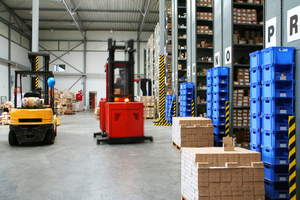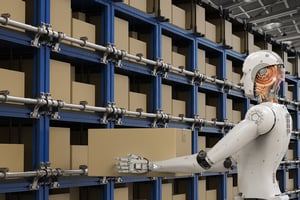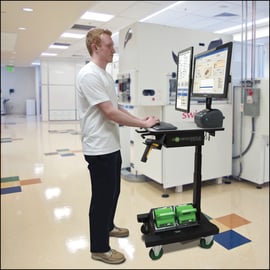
One area of staff retention and warehouse productivity that is frequently overlooked is the effect of ergonomics on production. Consciously or not, ergonomics pervades every aspect of facility management.
While some managers still look at ergonomics as a form of regulatory burden or reactionary response to a problem, successful leaders understand its ongoing importance. A proactive ergonomic focus helps organizations to maximize productivity and improve employee retention.
Prioritizing ergonomics drives management innovation in numerous ways.
The Impact of Smart Ergonomics
Ergonomics is not just about making the right choice for employees, it is also the best economic choice. Every $1 spent on ergonomics saves $10 in the form of:
- Reduced training costs due to improved employee retention
- Decreased injuries and illnesses among workers that result in lost time
- Reduced worker’s compensation claim costs
- Lower insurance premiums for employees
Warehouse Design and Workflow
 Improving warehouse layout and design also improves workflow. The result is an easier and more productive environment for workers. When work is easier to do, it will inherently be done faster with fewer injuries. While reactive ergonomic changes may sometimes be necessary, most ergonomic considerations and modifications should be done proactively to minimize worker injury and illness rates.
Improving warehouse layout and design also improves workflow. The result is an easier and more productive environment for workers. When work is easier to do, it will inherently be done faster with fewer injuries. While reactive ergonomic changes may sometimes be necessary, most ergonomic considerations and modifications should be done proactively to minimize worker injury and illness rates.
The 80/20 rule in warehousing explains that 20% of products in a facility are picked 80% of the time, making these high-movers vital to consider when evaluating ergonomic challenges.
Keeping vital products in locations that are readily accessible for people and machines provides necessary access, while grouping them closely together reduces travel time during picking. Strategically locating vital products near entrances and exits allows for faster restocking and shipping as well. When time is saved, so is an effort. Reducing travel time and picking difficulty minimizes repetitive actions like walking, climbing, and reaching to promote worker safety.
Strike Zone Every pick naturally causes some measure of fatigue or strain, and over time that can add up to pain and injury. Ergonomics is focused on enabling employees to do their jobs using more natural movements to minimize this strain. Zeroing in on the strike zone is a key component to preventing repetitive stress injuries.
Every pick naturally causes some measure of fatigue or strain, and over time that can add up to pain and injury. Ergonomics is focused on enabling employees to do their jobs using more natural movements to minimize this strain. Zeroing in on the strike zone is a key component to preventing repetitive stress injuries.
The strike zone is measured as the area from a worker’s shoulders to knuckles when the worker is standing upright. This is an ideal area for operating because movement within the strike zone does not result in significant biomechanical strain. Picking products within this area is optimal for shoulder, neck, and back function, resulting in less pain and injury than operating either above or below the strike zone.
Since muscle fatigue and strain can result from lifting or carrying heavy products, weightier items should be placed in the strike zone to minimize the negative effects of picking up and bringing down these products from above during the picking process.
Shelving HeightRearranging where inventory is located can go a long way in improving warehouse ergonomics. Storing high movers (especially those that are heavy) within the strike zone reduces the risk of falling from ladders because it decreases the number of times workers need to go up and down. Placing palletized items on the floor and allowing employees to pick from open tops can best utilize space while elevating products for more ergonomic picking.
Automation Integrating automation across warehouse operations reduces the human component. Less human physical exertion means fewer ergonomic effects over time. However, automation typically comes at a steep price, requiring a thorough cost-benefit analysis.
Integrating automation across warehouse operations reduces the human component. Less human physical exertion means fewer ergonomic effects over time. However, automation typically comes at a steep price, requiring a thorough cost-benefit analysis.
Staff Retention Approaches
Workers are more likely to stay where they feel protected, provided for, and valued. Ergonomics change the work environment to fit the worker, instead of asking the worker to assimilate into an environment that does not take his/her needs into consideration. The implication of this shift is that workers will not only physically be more capable of performing the functions of the role, but also be more inclined to do so for the long term. In this way, ergonomics facilitates worker retention.
ComfortBy minimizing loud sounds from printers, shredders, copiers, fans, and other recurring noises, the auditory strain is reduced. Similarly, using glare-reducing lighting makes viewing screens on computers, handhelds, and mobile devices easier, reducing eyestrain. Creating a more comfortable working environment where employees’ senses are protected mitigates headaches as well as neck and shoulder strain.
Stress and Fatigue Employers know that tired employees make mistakes, but fatigue is too often viewed in the simple sense of not getting enough sleep or rest. Worker fatigue can occur when muscles are stressed due to unnatural working conditions. Workplace furniture, workstation equipment, and personal equipment should align to keep workers in body-neutral positions while on the job.
Employers know that tired employees make mistakes, but fatigue is too often viewed in the simple sense of not getting enough sleep or rest. Worker fatigue can occur when muscles are stressed due to unnatural working conditions. Workplace furniture, workstation equipment, and personal equipment should align to keep workers in body-neutral positions while on the job.
Work station components must be adjustable to eliminate muscle strain while desks and tables should allow proper height, width, and depth movement with chairs. Additionally, workers need to understand how to make the necessary adjustments to seats, monitors, and other components to protect themselves from muscle strain. Without this knowledge, the capability to customize a workspace does little to benefit employees on the job.
Ergonomic accommodations such as lumbar support pillows, headsets, and energy-absorbing mats can also be made available to workers to alleviate the physical stresses of their job requirements.
EfficiencyCentrally locating shared items like printers increases efficiency, which also reduces ergonomic risks for employees. Similarly, making essentials like bathrooms, break rooms, and parking easy for employees to access can significantly affect individual productivity throughout the workday, which quickly adds up across the organization over the course of a year.
Good Management Habits
Walk the Plant FloorDuring a regular work day, walk through the warehouse to identify situations where workers are struggling with tasks and employing awkward postures or movements. Ensure existing ergonomic recommendations like safe lifting practices are being followed and employees are utilizing available safety equipment.
Reduce Forceful ExertionsEliminate heavy lifting and heavy load manipulations by using equipment to raise and lower loads instead of manual labor. Reducing forceful exertions not only reduces injuries, it also improves labor flexibility by physically enabling any employee to do any job.
Observe Desk WorkersDetermine if there are static sitting poses affecting worker comfort and wellness. While desk workers face fewer obvious risks than manufacturing and warehouse workers, they are still at high risk for sedentary-related pain and injury.
ListenRead through first-hand complaints from workers and documentation around worker’s compensation claims to determine where ergonomics can be improved. Regularly ask workers for anonymous feedback to get recommendations around everyday pain points. Maintain a suggestions box to encourage an environment of open communications and take all input seriously.
Find ResourcesUse the NIOSH checklist as a starting point and look for industry or application-specific information to improve existing ergonomic efforts.
Leveraging Unique Technologies
Warehouse automation advances are increasingly focused on not just time savings and improved accuracy, but also ergonomic advantages. Progressive approaches to ergonomics include relying on technological innovations to supplement or replace worker labor in warehouse operations.
Vertical Lift Warehouse Modules While the cost of a vertical lift warehouse module cannot be justified simply based on ergonomics alone, the ergonomic benefits it provides are immediately evident.
While the cost of a vertical lift warehouse module cannot be justified simply based on ergonomics alone, the ergonomic benefits it provides are immediately evident.
Time-saving advantages and scalability potential are the most common reasons for implementing this type of technology. However, these cost justifications also have positive ergonomic implications.
Utilizing a goods-to-person picking approach moves everything into the strike zone, which eliminates the need to bend, stretch, reach, lift, or climb. The result is substantially diminished muscle strain and a much lower risk of injury. Additionally, eliminating worker travel through expansive warehouse spaces reduces the size of the area that needs to be optimally lit to promote eye health and reduce overall fatigue.
Automated Vertical WarehousingA vertical lift warehouse module that utilizes a robotic arm to retrieve boxes from a picking bay and place them on existing conveyor belts makes warehousing even more ergonomic. This versatile solution can be installed anywhere, even places where workers cannot or should not be working. The result is greater efficiency without compromising worker safety as a business scales operations.
Rather than seeing Ergonomics as a burden that is put upon your business from outside, it pays to think of it as one additional area of specialization where you might be able to gain a competitive advantage in your industry in terms of staff retention, brand reputation and productivity improvements with some non-typical methods and approaches. Even if your business is not big enough to incorporate an Ergonomics specialist full-time (something not uncommon in many large call centers since the 1990's), the benefits of bringing in some outside expertise to review your current practices would have long-term benefits.










